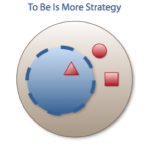
Ten Reasons You Need a Life Mission Statement
For decades we have heard of the importance of the life mission statement sometimes referred to as a personal mantra or life purpose idea. But do you really need one? Can a simple little phrase make that much of a difference in your life?
The intentional living genre is literally the size of an ocean. Everyone is showing you a better way to “succeed in life” or a better methodology for planning your life or a new recipe for how to make New Year’s resolutions that don’t suck.
And just about all of these approaches point to some kind of life mission statement or idea that’s a part of the mix. But most are ineffective. The reasons are pretty straightforward. The examples are often too generic or too lengthy because they are written on a whim without the context of good process and meaningful reflection.
For example, a top ranked Google search reveals a Fast Company article where they share the life mission statements of five famous CEOs. Two examples are:
- “To have fun in my journey through life and learn from my mistakes.”
- “To serve as a leader, live a balanced life, and apply ethical principles to make a significant difference.”
Really? While these sound nice they are a little too impotent and general, lacking a dynamic specificity. When people read examples like these it’s all too easy to write off the idea of having a personal life mission.
But in reality knowing your mission can be one of life’s most powerful tools.
Several years ago, I launched Life Younique, a training company that certifies church leaders to offer gospel-centered life designthrough their church. I have been passionate about helping people get life mission right–what exactly is the best way to know and name what God has created you to do?
So let’s start with the what and the why of life mission. (We will leave how to write one for a different post.) Years ago I decided to call life mission a “LifeCall” statement. The most important reason is to see your mission in life as something created, designed and given by God. Therefore we are called not just to follow Jesus (common call to all people) but we are called to accomplish something specific as a one-of-a-kind saint (your special assignment from God).
Your LifeCall is a brief and bold big idea that best captures today what God made you to do. Think of it as a golden compass pointing the way or a silver golden thread that weaves through every activity of your life. It’s the enduring rally cry of team-you; it’s the victory banner waving over everything you do. Ideally, every priority, project and penny is filtered through, guided by and championed for your LifeCall. Imagine every person in your sphere of influence being blessed better, served stronger and loved longer because you form a unique life mission every day.
Let’s unpack the definition a bit further: LifeCall is a brief and bold big idea that best captures today what God made you to do.
- It’s brief: Stay between six and 12 words
- It’s bold: Declare something that fires you up and makes you confident
- It’s big: Account for every relationship, domain or “compartment” of your life
- It’s best for today: Write it down now, even though it may improve over time
- It’s about God: Reflect God’s goodness and testify to his creative genius that is you
- It’s about doing: Capture a “being-doing fusion” that ultimately clarifies active output
Why is the knowing and naming your LifeCall so important? In a nutshell your LifeCall enables you to do more of what you do best. It enhances every aspect of what it means to be human; to be alive as a follower of Jesus. Ponder these 10 benefits. Your LifeCall:
- Solidifies personal identity in a way that nourishes intimacy with the God who created you
- Generates internal confidence by revealing how God can use you each day
- Unlocks deeper motivation that energizes your tasks and relationships
- Refreshes others-centered thinking to build more love into the core of your being
- Shapes vocational planning that moves toward increased value to the world
- Empowers focused living by fortifying your resolve to say “no”
- Diagnoses frustrating misalignments in the variety of life’s roles at home and work
- Provides long-term orientation in the midst of suffering or difficult circumstances
- Produces increased passion that leads toward greater mastery and autonomy
- Guides lifelong dreaming that fills your days with optimism and hope
As you reflect on the power and beauty of articulating your own LifeCall, which one of the reasons is most significant to you at the beginning of 2018?
What is my LifeCall by the way? It’s to help you make yours more clear of course. But this is how I say it: Will exists to make a life of more meaningful progress more accessible to every believer.
I have not written many blog posts this last year because I am working on my next book entitled Younique: Designing the Life that God Dreamed for You. I look forward to sharing more with you in 2018.
> Find out more about Younique here.

Tags: Life Call, Life Mission Statement, Will Mancini, younique















 A “more is more” approach is seen in a church in which the basic operating assumption is that the more programs a church can offer in the “church space” the better. The hope is that more programs will attract more people and provide opportunities for spiritual growth.
A “more is more” approach is seen in a church in which the basic operating assumption is that the more programs a church can offer in the “church space” the better. The hope is that more programs will attract more people and provide opportunities for spiritual growth. The “less is more” approach operates with the assumption that the church should provide a few high quality offerings. Whether or not these offerings take place in church space or life space is a variable. In addition, the church attempts to design these offerings so that they have a meaningful relationship to one another. Ideally, the program offerings are designed around a unified set of output (discipleship) results.
The “less is more” approach operates with the assumption that the church should provide a few high quality offerings. Whether or not these offerings take place in church space or life space is a variable. In addition, the church attempts to design these offerings so that they have a meaningful relationship to one another. Ideally, the program offerings are designed around a unified set of output (discipleship) results. TO BE IS MORE
TO BE IS MORE








